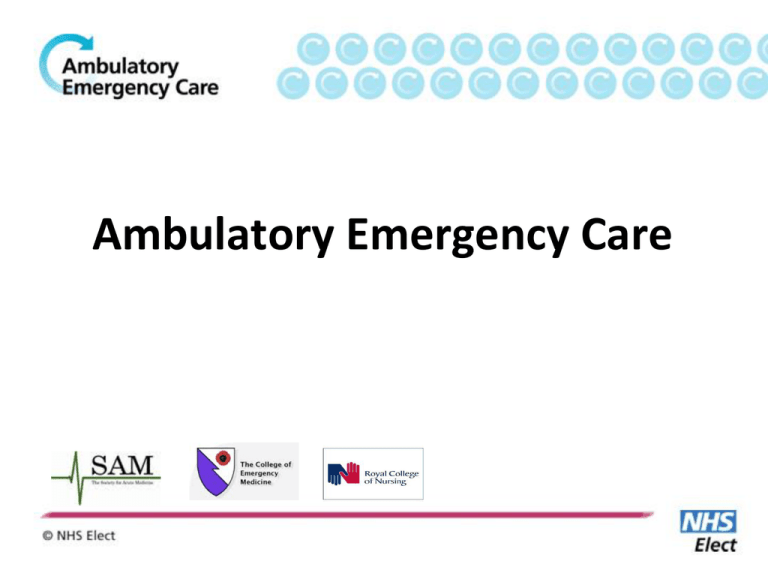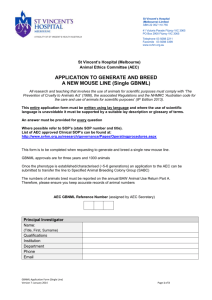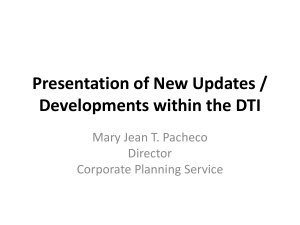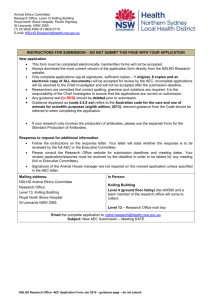
Ambulatory Emergency Care
Background
Ambulatory Emergency Care is a way of managing a
significant proportion of emergency patients on the same day
without admission to a hospital bed
It is a transformational change in care delivery – AEC has the
potential to be as significant to emergency care as day case
surgery is to elective care
Directory of AEC for adults
What’s in a name?
Ambulatory Emergency Care
Clinical Decisions Units
Same Day Emergency Care
What is AEC?
“Ambulatory care is clinical care which may include
diagnosis, observation, treatment, and rehabilitation, not
provided within the traditional hospital bed base or within the
traditional out-patient services that can be provided across
the primary/secondary care interface”.
The Royal College of Physicians – Acute Medicine Task Force & endorsed
by the College of Emergency Medicine, 2012
….What is it about?
• Improving patient experience
• Reducing waits for tests
• Early and frequent senior review
• Improving patient flow
And so better outcomes for patients
High Volume Clinical Scenarios (BPT)
•
•
•
•
•
•
•
•
•
Abdominal Pain
Acute Headache
Anaemia
Appendicular Fracture
Asthma
Bladder Outflow Obstruction
Cellulitis
Chest Pain
Community Acquired
Pneumonia
• Deliberate Self Harm
•
•
•
•
•
•
•
•
•
DVT
Epileptic Seizure
Falls inc. Syncope/Collapse
Low Risk Pubic Rami
LRTI without COPD
Minor Head Injury
PE
Renal/Ureteric Stones
SVT including AF
Same Day Emergency Care Rates 75th
Centile and National Average
AEC Delivery Network Proposed Timeline 12 Month Programme
Months
1
Preparation
with
organisations
2
3
4
Workshop 1
5
6
Workshop 2
7
8
9
10
Workshop 3
11
12
Workshop 4
Topic specific Webinars, virtual visit series (1- 2 x monthly)
1:1 team support (Initial site visit with each organisation plus ongoing support
to support implementation
Topic specific events eg measurement , clinical skills
Action periods
Local teams develop, test and implement changes
Input and support from expert Network Reference Group & national team
Cohort One
Cohort Two
•
•
•
•
•
•
•
•
•
•
•
•
•
•
•
•
•
•
•
•
•
Calderdale & Huddersfield
Harrogate
Hull
Leeds
Liverpool
Nottingham
Plymouth
Tyne & Wear
Weston Super Mare
Whittington
Bath
Bristol
Gloucester
Imperial
Milton Keynes
North Cumbria
North Lincs
Pennine
Pilgrim
Stockport
Warrington
Cohort Five
Cohort Six
•
•
•
•
•
•
•
•
•
•
•
•
•
•
•
•
•
•
•
•
•
•
•
•
•
•
•
•
Bournemouth
Bradford
Coventry and Warwickshire
East Cheshire
Guys & St Thomas
Lewisham
Lister – East & North Herts
Portsmouth
PRU Kings College
Southend
South Manchester
Tameside
West Sussex
Wye Valley
Yeovil
Cohort Three
•
Addenbrookes
•
Ashford CCG
•
Chester
•
Dudley
•
East Sussex
•
Heart of England
•
Kettering
•
Kings College
•
Peterborough
•
Sandwell and West Birmingham
•
St Helens and & Knowsley
•
Worcester
Aintree
Burton
Central Manchester
Gateshead
Leicester
Mid Essex
North Staffs
Royal Cornwall
Royal Free – inc. Barnet
Shrewsbury & Telford
Swindon
Walsall
West Middlesex
Cohort Four
•
•
•
•
•
•
•
•
•
•
•
•
•
•
•
Barnsley
Basildon
Croydon
Epsom
Heatherwood & Wexham
Herts Valleys CCG
Ipswich
Kingston
Mid Staffs
Northampton
Northwick Park
St Heliers
St Georges
Southport & Ormskirk
UCLH
Clinical Leads
Dr Vince Connolly
Dr Taj Hassan
Models of AEC - the 4Ps
Passive
receive referrals
Pathway driven
restricted to particular agreed pathways
Pull
senior clinician takes calls for emergency referrals
Process driven
all patients considered for AEC
New Process for GP Assessment and Ambulatory Care
Overarching principle; Treat all
patients as
Ambulatory until proven
otherwise
Non-Condition Specific
Row Labels
10/09/2012
20/08/2012
30/07/2012
09/07/2012
18/06/2012
28/05/2012
07/05/2012
16/04/2012
26/03/2012
05/03/2012
13/02/2012
23/01/2012
02/01/2012
12/12/2011
21/11/2011
31/10/2011
10/10/2011
19/09/2011
29/08/2011
08/08/2011
18/07/2011
27/06/2011
06/06/2011
16/05/2011
25/04/2011
04/04/2011
Individual Value
BF
BFH
BEFH
BEF
F
E
AEF
E
AE
BF
ABF
B
BF
B
A
Nottingham ‘process model’ What Did We Achieve….
We increased the amount of patients discharged with a LOS of less
than 11hrs
0-11
Special Cause Flag
140
120
100
80
60
40
The Amb Score
If Score is high, consider re-direct to
ambulatory care unit
FACTORS
Female sex
Age < 80 years
Has access to personal / public transport
IV treatment not anticipated by referring doctor
Not acutely confused
MEWS score = 0
Not discharged from hospital within previous
30 days
TOTAL Amb Score (Maximum 7)
1 if applicable
0 if not applicable
Ala L, Mack J,
Shaw R, Gasson A.
The Amb Score: A
pilot study to develop
a scoring system to
identify which
emergency medical
referrals would be
suitable for
Ambulatory care
management. Acute
Medicine 2010; 9: 139
(Abstract)
Programme measures - tips
Aim for standard cohort wide data collection
Suggested measures are in the guide including:
• Patient experience / staff experience
• Number of non elective bed days used per month
• Number of 0 LOS patients
• Number of medical outliers
• AEC activity (New and follow up)
• Emergency readmissions (7 day)
• Emergency patient flow (4 hour performance)
Use the 7 step model - baseline, frequent measurement,
review, use the 7 points rules
The ROI tool
Two stages assesses actual impact and future impact
The EBD Tool Kit
•
•
•
•
•
•
•
•
Introducing the AEC Service - Patient Leaflet
The Ambulatory Emergency Care Journey
AEC Short Animated Film
Using SMS Mobile Text Messaging Feedback
Patient Experience Questionnaire
Volunteer’s Log Book
A day in the life of... To capture staff experience
Staff Perspective on patient journeys
Chester - Patient Experience
Emotional mapping
Patient
arrives at
car park
Patient
navigates
to ED
Patient
registers
with ED
reception
It took ages to find a car parking space
and then I found it was a 15 minute walk
to the AEC clinic. How frustrating!
+ve
relieved
The triage
nurse
refers the
patient to
AEC
Patient finds their
way t o AEC
Informed
Frustrated
worried
-ve
Patient waits
for
treatment
The room was
cluttered with out of
date magazines and
notices on the walls
and I was already
feeling really nervous
Pleased
pleased
relieved
Lost
nervous
upset
Patient is seen
by clinician
I wasn’t sure where to
go – the signs were
difficult to follow
I was
anxious I
didn’t know
what
ambulatory
meant was
this good or
bad?
anxious
AEC staff
greet patient
and staff
explain what
to expect
anxious
The NHS Sustainability Model
Programme Sustainability – 57.28
infrastructures
Fit with the organisations strategic aims and culture
Clinical leadership engagement and support
Senior leadership engagement and support
Staff behaviours toward sustaining the change
Staff involvement and training to sustain the process
Effectiveness of the system to monitor progress
Adaptability of improved process
Credibility of the benefits
Benefits beyond helping patients
0
2
4
6
8
10
12
14
16
Areas to focus on
• Infrastructures
• Senior leadership
• Effectiveness of the system to
monitor progress
The Benefits
Value for money
‘ Definitely good value for money’ for what we have paid we will definitely get ROI, by admissions
saved”
‘Would happily pay join the network again’ knowing what we know now.’
Improved service design
"I love the web seminars - they're a great way of learning without travelling miles and I can get the
messages to the rest of the team.“
“The network has ‘definitely and undoubtedly’ helped us move forward.”
Speed of service development
”It has been very useful seeing what other organisations have done . The networking has given us
examples to take back to our Trusts and get funding and sign off faster than usual”
“Ambulatory Care unit evolved even faster because of our involvement in Ambulatory
Emergency Care Delivery Network”
Reported benefits of being in the Network
• Investment for a 2.9m bespoke AEC unit (Whittington)
• AEC has really helped patient flow and achieving the target
(Kettering)
• 50% of our GP referrals are now managed in AEC (Notts)
• 83% of surgical patients processed via AEC are saved at least
1 night in hospital (Bath)
• 134 patients were seen during our pilot and all admissions
avoided (Glos)
March 2013
“Waiting times at Milton Keynes
Hospital’s A&E department are
some of the longest in the
country.”
June 2013
“Shadow Health
Secretary Andy
Burnham visited
the hospital to
see how a new
ambulatory care
unit, giving
patients a "short,
sharp treatment",
had helped turn
around the
department”
DUDLEY PILOT
OUTCOMES
•
•
•
•
•
•
1810 patients seen in AEC during the 3 month pilot
AEC admission rates through the 3 months ranged from 24% - 31%
‘0’ Days LoS increased by 6%
EAU discharge rate increased by 1%
Average LoS in EAU down by 1.7hrs
Full year effect on closing beds is 4.13 beds (+4 trolley spaces closed
for space to run AEC)
• Full year effect cost saving realised £234,219
• Friends & Family Score of 73
What has happened? – Surgical AEC
Approximately 140 patients seen per month
Outcome
Percentage (%)
Home same day
48
Home same day after local
procedure/dressings
34
Operation same day
10
Admit as normal
5
Minimum of 82% of patients go home the
same day and are saved a hospital stay
Other Impacts
Wait for an operation for “urgent non-life threatening” problem
3.5
3
Days
2.5
2
1.5
1
2012
0.5
New Service
0
May
June
July
Impact on In-patients
August
Why do it?... Staff and pts love it
All aspects of care were very
good. The staff was efficient and
courteous, the nurses were
professional and caring; the
doctors were professional,
personable and knowledgeable.
A lot of good old common sense
evidenced throughout
Everyone was really helpful,
friendly and relaxed, which made
it very supportive for me
Everyone was so helpful; and very
kind. I was less stressed after my
care
Everyone was wonderful. Thank
you so much for allaying my fears
It feels great to provide great
quality care without all that
waiting around
Got treated fairly quickly because
was in pain/bleeding. Didn't have
to stay in hospital to have IV
antibiotics - excellent. Excellent
and sensitive nurses. Got better!
35
The bigger picture
Best Practice Tariffs for Ambulatory
Emergency Care
Places cost £99 plus £6.59 booking fee, to book your place to go:
https://ambulatoryemergencycare.eventbrite.co.uk
Contact details
If you have a query or want to access work shared by other
organisations please use:
aec@nhselect.org.uk
deborahataec@nhselect.org.uk
www.ambulatoryemergencycare.org.uk












